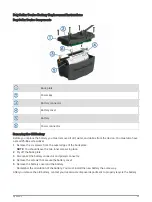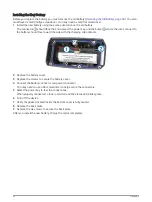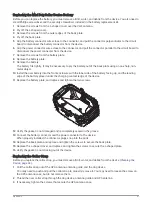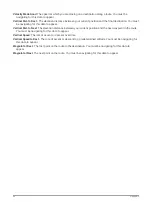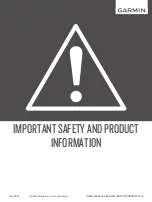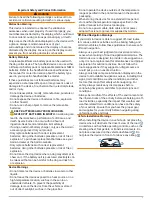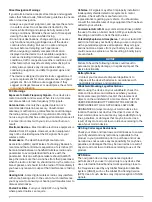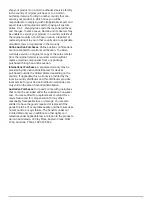
Street Navigation Warnings
If your Garmin device accepts street maps and suggests
routes that follow roads, follow these guidelines to ensure
safe on-road navigation.
• Always use your best judgment, and operate the vehicle
in a safe manner. Do not become distracted by the
device while driving, and always be fully aware of all
driving conditions. Minimize the amount of time spent
viewing the device screen while driving.
• Do not input destinations, change settings, or access
any functions requiring prolonged use of the device
controls while driving. Pull over in a safe and legal
manner before attempting such operations.
• When navigating, carefully compare information
displayed on the device to all available navigation
sources, including road signs, road closures, road
conditions, traffic congestion, weather conditions, and
other factors that may affect safety while driving. For
safety, always resolve any discrepancies before
continuing navigation, and defer to posted signs and
conditions.
• The device is designed to provide route suggestions. It
is not a replacement for driver attentiveness and good
judgement. Do not follow route suggestions if they
suggest an illegal maneuver or would place the vehicle
in an unsafe situation.
FCC Warnings
Exposure to Radio Frequency Signals–Your device is a
radio transmitter and receiver. When it is on, it receives
and also sends out radio frequency (RF) signals.
Antenna Care–Use only the supplied antenna or a
recommended antenna accessory. Unauthorized
antennas, modifications, or attachments could damage
the radio and may violate FCC regulations. Warning: Do
not use any radio that has a damaged antenna, because if
it comes into contact with your skin, a minor burn can
result.
Electronic Devices–Most modern electronic equipment is
shielded from RF signals. However, certain equipment
may not be shielded against the RF signals from your
wireless radio.
Pacemakers–The Health Industry Manufacturers
Association (HIMA) and Wireless Technology Research
recommend that a minimum separation of six inches (6”)
be maintained between a handheld wireless radio and a
pacemaker to avoid potential interference with the
pacemaker. Persons with pacemakers should ALWAYS
keep the radio more than six inches from their pacemaker
when the radio is turned on, should not carry the radio in a
breast pocket, and should turn the radio off immediately if
you have any reason to suspect that interference is taking
place.
Hearing Aids–Some digital wireless radios may interfere
with some hearing aids. In the event of such interference,
you may want to consult your hearing aid manufacturer to
discuss alternatives.
Posted Facilities–Turn your radio OFF in any facility
where posted notices so require.
Vehicles–RF signals may affect improperly installed or
inadequately shielded electronic systems in motor
vehicles. Check with the manufacturer or its
representative regarding your vehicle. You should also
consult the manufacturer of any equipment that has been
added to your vehicle.
Commercial Aircraft–Many commercial airlines prohibit
the use of radios on board. Switch OFF your radio before
boarding an aircraft or check the airline rules.
Potentially Explosive Atmospheres–Turn your radio OFF
and do not remove your battery when you are in any area
with a potentially explosive atmosphere. Obey all signs
and instructions. Sparks from your battery in such areas
could cause an explosion or fire resulting in bodily injury
or even death.
NOTICE
Failure to heed the following notices could result in
personal or property damage, or negatively impact the
device functionality.
Battery Notices
• Contact your local waste disposal department to
dispose of the device/batteries in accordance with
applicable local laws and regulations.
Windshield Mounting Legal Restrictions
Before using the device on your windshield, check the
state and local laws and ordinances where you drive.
Some state laws prohibit or restrict the placement of
objects on the windshield of a motor vehicle. IT IS THE
USER'S RESPONSIBILITY TO MOUNT THE DEVICE IN
COMPLIANCE WITH ALL APPLICABLE LAWS AND
ORDINANCES. Always mount your Garmin device in a
location that does not obstruct the driver's view of the
road. Garmin does not assume any responsibility for any
fines, penalties, or damages that may be incurred as a
result of any state or local law or ordinance relating to the
use of your Garmin device.
GPS Dog Collar Legal Restrictions
Check your state and local laws and ordinances to ensure
you fully understand any restrictions applicable to this
product in your jurisdiction prior to purchase and/or use.
Garmin does not assume any responsibility for any fines,
penalties, or damages that may be incurred as a result of
any state or local law or ordinance relating to use of the
product.
GPS Notice
The navigation device may experience degraded
performance if you use it in proximity to any device that
uses a terrestrial broadband network operating close to
the frequencies used by any Global Navigation Satellite
System (GNSS), such as the Global Positioning Service
(GPS). Use of such devices may impair reception of GNSS
signals.
4


